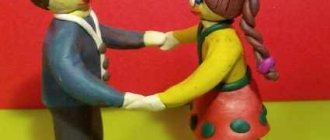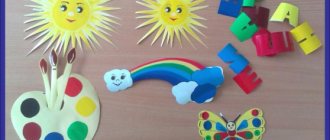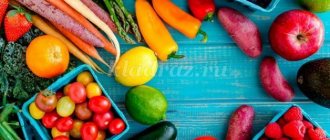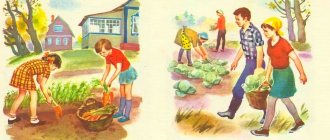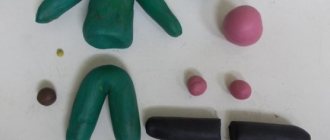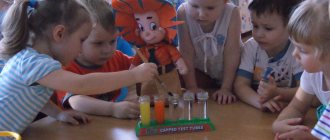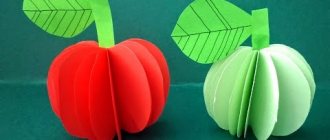Abstract of the GCD for modeling “Harvest in the garden” in the senior group
Victoria Vasilyeva Summary of the educational method for modeling “Harvest in the garden” in the senior group
Goal: to be able to convey the characteristic features of each vegetable in sculpting.
— Learn to create scenes with homogeneous objects, placing several figures on one stand;
— Learn to compare the shape of vegetables and fruits with geometric shapes;
— Enrich children’s speech with adjectives that characterize properties and qualities.
— To form the logical thinking of a preschooler through solving a problem situation;
— Develop the ability to sculpt familiar objects (vegetables) from life and from imagination, to depict their characteristic features.
— Cultivate the desire to complete the work started;
— Cultivate accuracy in work;
— Develop creativity, imagination, encourage creative discoveries and children’s desire to independently decide on an image;
— Cultivate interest in Russian folklore and riddles.
Preliminary work: examining subject pictures from the “Vegetables” series, coloring coloring books with vegetables, the didactic game “Wonderful Bag”, learning finger exercises.
Equipment: Envelope with a letter, plasticine, stacks, modeling boards, models of vegetables, teaching material on the topic “vegetables”.
(Knock on the door). The teacher brings an envelope with a letter.
- Look, they brought a letter from the forest from the Hare’s mother. They got into trouble. An evil Crow flew to their beds and took the entire harvest with it. Now Mama Hare will be left with her bunnies without tasty and healthy vegetables.
— They sent us a sad letter. Guys, do you think we can help the Hare?
(listen to the children's answers)
Educator: Guys, today I suggest you make a garden with a harvest for the bunnies. Let's take a closer look at vegetables. Children look at dummies and images of vegetables, the “Vegetable Garden” poster, specifying the features of their appearance (structure and coloring, shape of leaves, how vegetables grow in the garden bed)
Before we get to work, let's warm up a little.
One, two, three, four, (Walking in place)
Children learned vegetables: (Jumping in place)
Onion, radish, zucchini, (Tilts left and right)
Horseradish, carrots, garlic (Hand clapping)
Children are invited to the tables. There is plasticine and boards on the tables, the teacher explains the sequence of work.
Explanation and demonstration of the sequence and techniques of sculpting:
We make a ball from red plasticine. We make a flat cake from dark green plasticine. Cut out a star from the flatbread. We connect the details. We bend the leaves slightly upward. We sculpt a twig from dark green plasticine.
We make a ball from purple plasticine. Then we pull it out a little to make a droplet. We make a star from dark green plasticine, as for a tomato. Only fold the eggplant leaves down. Let's make a small branch.
To sculpt cabbage, prepare and knead green plasticine in your hands. Divide the prepared piece into small slices for sculpting cabbage leaves. Mash each slice in your hands, then press it on top with your fingers and stretch it to form thin oval-shaped cakes. Leave one part in the form of a ball. Make a ball with the center of the fruit, and stick leaves around it in the shape of a green rose.
To sculpt carrots you need green and orange plasticine. The fruits of this vegetable are oblong cone-shaped pieces that have pimples. To show them, use the stack again and pierce the soft plasticine in a random order. Make oblong leaves from green plasticine. Attach the leaves to the fruits.
We chop and chop the cabbage (swinging movements with our hands, like an ax
We knead the cabbage, knead the cabbage, (“knead the cabbage”)
We salt and salt the cabbage (“take” a pinch of salt and “salt”)
We press and press cabbage. (flexion and extension of the hands)
The teacher instructs each child to sculpt their own beds so that the garden is “rich.” The children choose a material and begin to sculpt while listening to calm music. As I work, I help children who have difficulty choosing sculpting methods.
Source
Progress of the lesson
Show children object pictures with berries, asking them to name each berry. You can play with the guys the game “Which berry is missing?” Among the missing berries, hide the grapes last.
Then look at the grape sprig with the children. Notice how the oval berries are arranged on it, how beautiful the carved leaves are - they look like maple leaves, only smaller.
Offer to sculpt a sprig of grapes on cardboard. To do this, you need to roll up green sausages and place a branch out of them on cardboard; Roll a green ball, flatten it between your palms and cut out the outlines of a leaf using a stack. Attach the leaf to the cardboard. Tear off small pieces from light green or purple plasticine, roll them between your palms into ovals and attach them to a branch in rows: the first row is the longest (5-6 berries), the second is shorter, etc.
Abstract of the GCD for modeling “Harvest in the garden” in the senior group
Victoria Vasilyeva
Abstract of the GCD for modeling “Harvest in the garden” in the senior group
Goal: to be able to convey the characteristic features of each vegetable in sculpting.
Tasks:
— Learn to create scenes with homogeneous objects, placing several figures on one stand;
— Learn to compare the shape of vegetables and fruits with geometric shapes;
— Enrich children’s speech with adjectives that characterize properties and qualities.
— To form the logical thinking of a preschooler through solving a problem situation;
— Develop the ability to sculpt familiar objects (vegetables) from life and from imagination, to depict their characteristic features.
— Cultivate the desire to complete the work started;
— Cultivate accuracy in work;
— Develop creativity, imagination, encourage creative discoveries and children’s desire to independently decide on an image;
— Cultivate interest in Russian folklore and riddles.
Preliminary work: examining subject pictures from the “Vegetables” series, coloring coloring books with vegetables, the didactic game “Wonderful Bag”, learning finger exercises.
Equipment: Envelope with a letter, plasticine, stacks, modeling boards, models of vegetables, teaching material on the topic “vegetables”.
Progress of the lesson:
Educator: Guys, autumn has come, time to harvest vegetables .
(Knock on the door). The teacher brings an envelope with a letter.
- Look, they brought a letter from the forest from the Hare’s mother. They got into trouble. An evil Crow flew to their beds and the entire harvest with it. Now Mama Hare will be left with her bunnies without tasty and healthy vegetables.
— They sent us a sad letter. Guys, do you think we can help the Hare?
(listen to the children's answers)
Educator: Guys, today I suggest you make a garden with a harvest for the bunnies. Let's take a closer look at vegetables. Children look at dummies and images of vegetables, the “Vegetable Garden” poster, specifying the features of their appearance (structure and coloring, shape of leaves, how vegetables grow in the garden bed)
Before we get to work, let's warm up a little.
Physical exercise "Vegetables"
One, two, three, four, (Walking in place)
Children learned vegetables: (Jumping in place)
Onion, radish, zucchini, (Tilts left and right)
Horseradish, carrots, garlic (Hand clapping)
Children are invited to the tables. There is plasticine and boards on the tables, the teacher explains the sequence of work.
Explanation and demonstration of the sequence and techniques of sculpting:
Making tomatoes:
We make a ball from red plasticine. We make a flat cake from dark green plasticine. Cut out a star from the flatbread. We connect the details. We bend the leaves slightly upward. We sculpt a twig from dark green plasticine.
Making the eggplant:
We make a ball from purple plasticine. Then we pull it out a little to make a droplet. We make a star from dark green plasticine, as for a tomato. Only fold the eggplant leaves down. Let's make a small branch.
Making cabbage:
To sculpt cabbage, prepare and knead green plasticine in your hands. Divide the prepared piece into small slices for sculpting cabbage leaves. Mash each slice in your hands, then press it on top with your fingers and stretch it to form thin oval-shaped cakes. Leave one part in the form of a ball. Make a ball with the center of the fruit, and stick leaves around it in the shape of a green rose.
Making carrots:
To sculpt carrots you need green and orange plasticine. The fruits of this vegetable are oblong cone-shaped pieces that have pimples. To show them, use the stack again and pierce the soft plasticine in a random order. Make oblong leaves from green plasticine. Attach the leaves to the fruits.
Finger gymnastics "Cabbage"
We chop and chop the cabbage (swinging movements with our hands, like an ax
We knead the cabbage, knead the cabbage, (“knead the cabbage”)
We salt and salt the cabbage (“take” a pinch of salt and “salt”)
We press and press cabbage. (flexion and extension of the hands)
The teacher instructs each child to sculpt their own beds so that the garden is “rich.” The children choose a material and begin to sculpt while listening to calm music. As I work, I help children who have difficulty choosing sculpting methods.
Source
Progress of the lesson
Read N. Nishcheva’s poem to the children:
Let's go to the garden and collect the harvest. We will grow carrots and dig up potatoes. We will cut a head of cabbage, round, juicy, very tasty, and pick a little sorrel. And let's go back along the path.
Ask the children: “What vegetables did we come across in this poem? (Carrots, potatoes, cabbage, sorrel.)
What other vegetables do you know? (Children's answers.)
Invite children to look at replicas of eggplant, peppers, beets, turnips, onions and other vegetables. Pay attention to their shape and color.
After this, each child chooses the vegetables that he will sculpt, independently selects the color of the plasticine and sculpts the vegetables of the desired size.
A child can fashion 2-3 vegetables and then put them in a molded plate.
To make a plate, roll out a large ball, flatten it into a disk, press in the middle, pull it back with your fingers and trim the edges.
Summary of GCD for modeling in the senior group “Vegetables”
Gulperi Magomedova
Summary of GCD for modeling in the senior group “Vegetables”
sculpting techniques , rolling, stretching, pressing.
vegetables) from life , conveying their character and features;
2) Develop an eye;
3) Strengthen the skills of careful modeling (do not throw plasticine around, do not stain clothes)
4) Cultivate interest in Russian folklore and riddles.
Equipment: Plasticine, stacks, backing board, napkin, dummies of vegetables .
-show your child how to work with a piece of plasticine
-help the child with difficulty
Progress of the lesson
Give the children riddles: Round, ruddy, I grow on a branch: Adults and little children love me. (Apple)
Balls hang on the branches, Turned blue from the heat. (Plums)
A hurricane hit the island, the last one remained on the palm tree... (Banana)
Examine with your children models of fruits that are complex in shape: banana, pear, peach, apricot, etc. Pay attention to their shape and color.
After this, each child chooses the fruits that he will sculpt, independently selects the colors and sculpts the fruits in the appropriate sizes.
The child then places the sculpted fruits in a vase. To make a vase, roll a large ball, then press a hole on one side with your thumb, make a depression with your fingers and compare the edges.
Separately, make a stand for the vase - roll it into a ball and flatten it into a cake.
Progress of the lesson
Read G. Sapgir’s poem to the children:
The owl is gray, the owl is old, And the eyes burn like headlights. The eagle owl - jump, the eagle owl - leap, and gave the little owl a flag. Little Owl is glad, glad - Two lanterns are burning.
Ask the children: “Who is this poem about? (About the owl.)
What do the eyes of an eagle owl look like? (Children's answers.)
Invite the children to look at a fir cone and think about how they can turn it into an eagle owl: place the cone with the sharp end down, sculpt large oval eyes, a nose, tassel ears from plasticine and attach them to the top of the cone. Place the paws in the form of balls at the bottom of the cone.
You can sculpt a stump from plasticine and attach an eagle owl to it.
